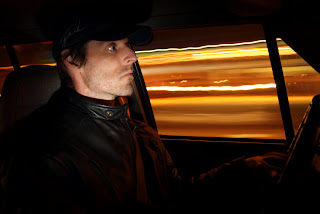But first, what is front curtain sync?

Front curtain sync is a shooting mode that you can choose to use in order to obtain some more creative images. It is commonly known as “flash and burn”, and that actually describes it better. To use the adage “in a nutshell” to explain front curtain sync, it would go something like this; as the shutter is released the flash fires and then the shutter remains open in order to “burn in” the rest of the image. The shutter opens, and captures the part of the image covered by the flash, but the rest of the image needs more time to develop. Nutshell closed.
There is both a front, and rear curtain sync. By simply reversing the time that the flash fires (either at the opening or the closing of a long shutter opening) the name is given.
I like to play with front and rear curtain syncs and I try to get more and more creative. We have all seen the images of a train going by with the flash firing in one of these modes. Most camera manuals proudly show such images in their pages, and I suppose that these images are helpful, but boring.
Setting it up.
I had some time to “flash and burn away”, so I took it step by step. I made only one or two mistakes which I will share with you all. I started by securing a tripod on the passenger side floor of my car. I ended up using a seat belt, some Bogen Super Clamps, and a stiff flexible arm; all in unison, to lock down my tripod.
I added my Nikon D-200 to the tripod, and attached a MC-30 in order to fire the camera from the driver’s seat, while driving. Next I used another Bogen Super Clamp in order to attach a single Nikon SB-28 to one of the tripods legs. This flash was fired wirelessly, all though that probably wasn’t necessary at all since it was so close to the camera body. I only intended to light up my head with the flash, so I added a gridded snoot to the flash in order to better contain the light spillage.

Camera settings.
I placed the camera in auto focus, but I later found out that I had made a mistake. I failed to set the spot of focus to the spot that my head would soon be. I think that the focus was on my driver’s side door, but that’s how we all learn, right? I could set the focus as I drove along by pressing the MC-30 down about half way. Once it was focused I could time the shutter release to expose the image as I passed by interesting background lights.
In order to get the camera into Front Curtain Sync mode, I turned the cameras shooting mode to Manual. Well, it is always on manual mode, but for sake of this post let’s just say that I did this step.
Next, I dialed down the shutter speed to taste, testing the time that the shutter remained open, and stuck with a speed of 2.5, an aperture of F5, and an I.S.O. of 100. An I.S.O. of 100 would allow for very low noise with the long shutter speed that I was using.
I set the flash settings to front curtain sync, which is found on page 78 of the D-200s’ manual. The second mistake was possibly made right here. I can not be sure that I had to do this step because it is for the built in camera flash. It seemed to work fine both ways, but it made me feel better so I did it. If you decide to join me in this step, simply press and hold the flash setting button (lightning bolt) found on the camera body, and turn the aperture dial until the front curtain sync until the front curtain sync is displayed. Once again, it didn’t seem to make a difference, and I feel this step can be avoided completely.
I set the SB-28 flash on manual mode, I.S.O. 100, and at 1/16 power. After several test shots it was aimed and I was ready to roll. Please, do not flash yourself as you drive your car. I was driving very slowly, and most often in empty parking lots. I did see some interest in what I was doing, and I halted my operation as the police drove past me. I’m just saying…….
I would really love to hear your stories and your comments. Feel free to subscribe to the “All Things about Photography blog” now, as you may just miss the next great post.
Questions are always answered, and please be careful if you try this set up.
No comments:
Post a Comment